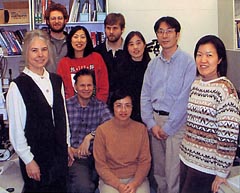  |
 |
 |
|
New
Beginnings
| Dr.
Kathleen S. Rockland |
| Head,
Laboratory for Cortical Organization and Systematics |
|
 |
 |
Members
of the Lab. for Cortical
Organization and Systematics (Myself, top left) |
I
first became acquainted with RIKEN almost 10 years ago, when I spent 6 weeks in
1991 as a visiting scientist in the Frontier Program. From this initial contact,
strong ties developed over the next few years, both of scientific interactions
and personal friendships. Thus, by joining BSI as head of a new laboratory within
the Cognitive Brain Science Group, I had the pleasant experience of participating
in a new venture, but also in some sense of "coming
home."
The process of setting up the new laboratory (Laboratory for Cortical Organization
and Systematics) began in February, 2000 and involved the standard progression
of milestones - planning out space, ordering equipment, recruiting and interviewing
potential staff members. For me, this was made all the more complicated by differences
between American and Japanese cultures, and especially by my not knowing either
written or spoken Japanese. Fortunately, I was able to draw on close assistance
from Planning Office staff and from Dr. Hisayuki Ojima, who was joining my lab
as senior scientist and subteam leader. The physical construction was largely
completed by April, and we were able to start experiments in June with four scientific
and technical staff members. The experimental focus of the lab uses a systems
neuroanatomical approach, which is concerned with large populations of neurons,
their interconnections, and the functional implications. As a first step, microinjections
of tracer substances are made in animal models, and the connections are mapped
by light microscopic analysis after histological processing. This can be extended
at even finer resolution to electron or confocal microscopy; and new tracers are
becoming available which may selectively target certain subpopulations, or which
may produce reversible effects. The combinations and interactions of these neural
networks result in large datasets which, like the gene chip microarrays, can quickly
frustrate the intuition. Determining how specific functions result from the concerted
activity of large neural populations has been successfully achieved for selected
subsystems, such as oculomotor control or reflex behaviors, but is still at an
early stage for higher cortical function. For instance, the inferotemporal cortex
in primates is known to be involved in object recognition from both behavioral
and single unit physiology experiments. The basic connectivity of this region
is also known, and is consistent with this function, but the actual neural substrates
and mechanisms remain to be elucidated. Just how do interconnected neuron populations
form the visual representations that result in perceptual experience? The interdisciplinary
tradition at BSI is well-suited to this type of investigation, and one direction
in my lab will address these issues in collaboration with colleagues using physiological
techniques.
In attending the recent BSI retreat and then the 3rd year anniversary, I have
been impressed by the central place given to humanistic values and questions of
broader societal concern. This expression seems an appropriate acknowledgement
of public trust in science and in our young institution. There is also the sense
of a new climate of Renaissance in the world, where brain science - with its relevance
for so many aspects of the human condition - may have a particular mandate.
In my move to Japan, I have been fortunate to be accompanied by my husband Charles
Rockland (Senior Research Specialist in ATDC), who is interested in integrative
organization and is completing a book on the associated coherence problematics,
with colleagues in Paris and Cambridge, MA. We have recently moved from the I-house
to an apartment in Mejiro, where we are enjoying the experience of city living
in Tokyo, and learning to read papers (alas, not yet "the
papersモ in the sense of Japanese newspapers) during the morning commute. We are
both looking forward to this end-of-year holiday season, and to beginning the
21st century (the century of the brain?) in our new surroundings. |
  |
|
|






